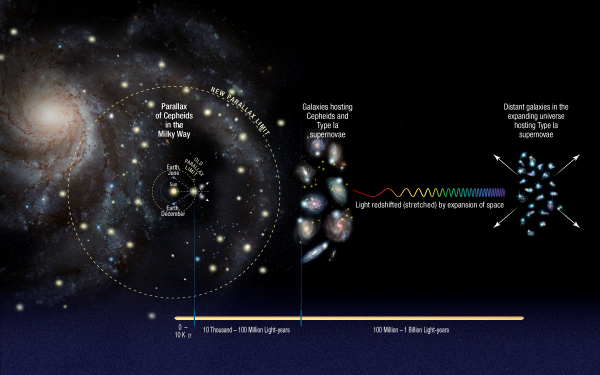Hubble finds Universe may be expanding faster than expected [heic1611]
2 June 2016
Astronomers have used Hubble to measure the distances to stars in nineteen galaxies more accurately than previously possible. They found that the Universe is currently expanding faster than the rate derived from measurements of the Universe shortly after the Big Bang. If confirmed, this apparent inconsistency may be an important clue to understanding three of the Universe's most elusive components: dark matter, dark energy and neutrinos.
 |
| Cosmic distance ladder. Credit: NASA, ESA, A. Feild (STScI), and A. Riess (STScI/JHU) |
A team of astronomers, led by Nobel Laureate Adam Riess and using the NASA/ESA Hubble Space Telescope, have discovered that the Universe is expanding between five and nine per cent faster than previously calculated. This is in clear discrepancy with the rate predicted from measurements of the infant Universe.
"This surprising finding may be an important clue to understanding those mysterious parts of the Universe that make up 95 per cent of everything and don't emit light, such as dark energy, dark matter, and dark radiation," explains Adam Riess of the Space Telescope Science Institute and the Johns Hopkins University, both in Baltimore, USA.
One possible explanation for this unexpectedly fast expansion of the Universe is a new type of subatomic particle that may have changed the balance of energy in the early Universe, so called dark radiation.
The team made the discovery by refining the measurement of how fast the Universe is expanding, a value called the Hubble constant, to unprecedented accuracy, reducing the uncertainty to only 2.4 per cent [1].
This new measurement presents a puzzle because it does not agree with the expansion rate found by looking at the moments shortly after the Big Bang. Measurements of the afterglow from the Big Bang from NASA's Wilkinson Microwave Anisotropy Probe (WMAP) and the European Space Agency's Planck satellite mission yield smaller predictions for the Hubble constant.
Comparing the Universe's expansion rate as calculated by WMAP and Planck (for the time after the Big Bang) and Hubble (for our modern Universe) is like building a bridge, Riess explains: "You start at two ends, and you expect to meet in the middle if all of your drawings are right and your measurements are right. But now the ends are not quite meeting in the middle and we want to know why."
This refined determination of the Hubble constant was made possible by making precise measurements of the distances to both nearby and faraway galaxies using Hubble [2]. The improved distance measurements were made by streamlining and strengthening the cosmic distance ladder, which astronomers use to measure accurate distances to galaxies. The team compared these measured distances with the expansion of space as measured by the stretching of light from receding galaxies and these two values were then used to calculate the Hubble constant.
The team is continuing to use Hubble with the aim of reducing the uncertainty in the Hubble constant even further, their goal being to reach an uncertainty of just 1 per cent. Current telescopes such as the European Space Agency's Gaia satellite, and future telescopes such as the NASA/ESA/CSA James Webb Space Telescope (JWST) and the European Extremely Large Telescope (E-ELT) could also help astronomers make better measurements of the expansion rate and lead to a better understanding of our Universe and the laws that govern it.
Notes
[1] Before Hubble was launched in 1990, estimates of the Hubble constant varied by a factor of two. In the late 1990s the Hubble Space Telescope Key Project on the Extragalactic Distance Scale refined the value of the Hubble constant to within 10 per cent, accomplishing one of the telescope's key goals. The new, improved Hubble constant value is 73.02 kilometres per second per Megaparsec (where one Megaparsec is equivalent to 3.26 million light-years).
[2] For the calibration of relatively short distances the team observed Cepheid variables. These are pulsating stars which fade and brighten at rates that are proportional to their true brightness and this property allows astronomers to determine their distances. The researchers calibrated the distances to the Cepheids using a basic geometrical technique called parallax. With Hubble's sharp-eyed Wide Field Camera 3 (WFC3), they extended the parallax measurements further than previously possible, across the Milky Way galaxy. To get accurate distances to nearby galaxies, the team then looked for galaxies containing both Cepheids and Type Ia supernovae. Type Ia supernovae always have the same intrinsic brightness and are also bright enough to be seen at relatively large distances. By comparing the observed brightness of both types of stars in those nearby galaxies, the team could then accurately measure the true brightness of the supernova. Using this calibrated rung on the distance ladder the accurate distance to additional 300 type Ia supernovae in far-flung galaxies was calculated.
More information
The Hubble Space Telescope is a project of international cooperation between ESA and NASA.
The international team of astronomers in this study consists of Adam G. Riess (John Hopkins University, USA; STScI, USA), Lucas M. Macri (Texas A&M University, USA), Samantha L. Hoffmann (Texas A&M University, USA), Dan Scolnic (John Hopkins University, USA; University of Chicago, USA), Stefano Casertano (STScI, USA), Alexei V. Filippenko (University of California Berkeley, USA), Brad E. Tucker (University of California Berkeley, USA; Australian National University, Australia), Mark J. Reid (Harvard-Smithsonian Center for Astrophysics, USA), David O. Jones (John Hopkins University, USA), Jeffrey M. Silverman (University of Texas, USA), Ryan Chornock (Ohio University, USA), Peter Challis (Harvard-Smithsonian Center for Astrophysics, USA), Wenlong Yuan (Texas A&M University, USA),and Ryan J. Foley (University of Illinois at Urbana-Champaign, USA)
Contacts
Adam Riess
Space Telescope Science Institute
Baltimore, USA
Tel: +1 410 516 4474
Email: ariess![]() stsci.edu
stsci.edu
Mathias Jäger
ESA/Hubble, Public Information Officer
Garching bei München, Germany
Cell: +49 176 62397500
Email: mjaeger![]() partner.eso.org
partner.eso.org



